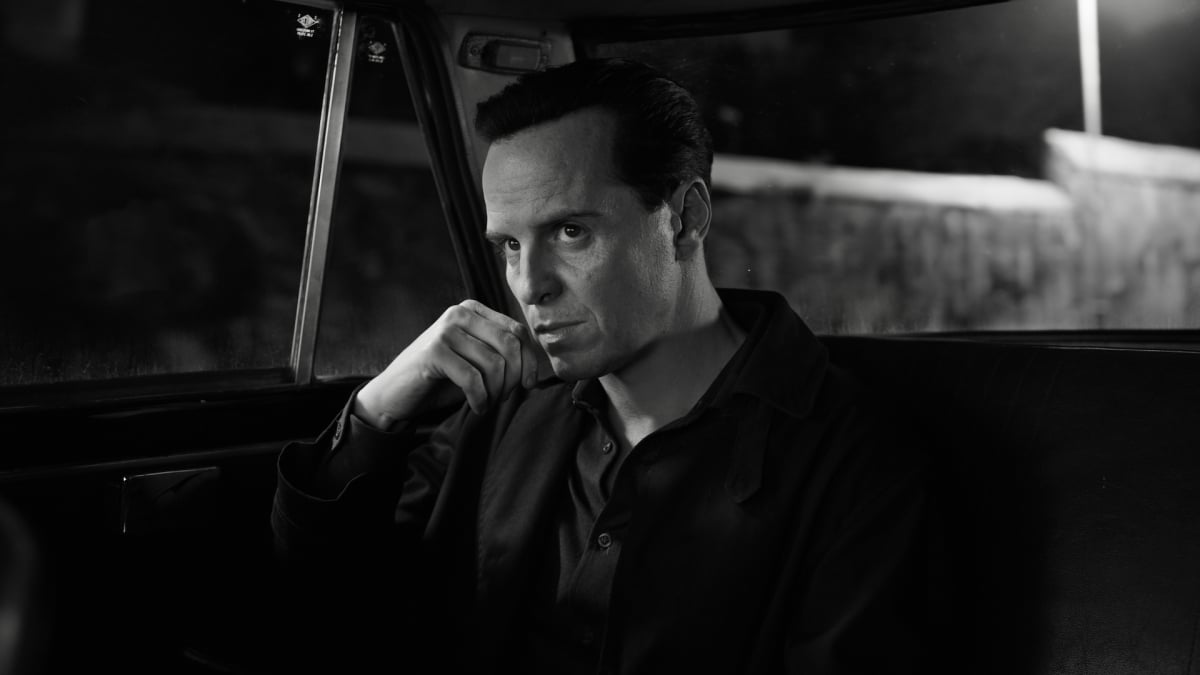Entertainment
‘Ripley’ review: Andrew Scott is a marvel in exquisite Highsmith adaptation

If you’re one for rapid-paced, action-packed thrillers, Patricia Highsmith’s classic 1955 novel The Talented Mr Ripley is already not for you. But if you’re one for slow-burn, sinister, underhandedly amorous thrillers, pour yourself the driest of martinis and settle into the latest adaptation of it, Ripley.
A meticulously captured suspense tale with a cold, classy, and understated performance from Andrew Scott, Netflix’s Ripley distills its long-revered source material into eight elegantly tailored acts. Brimming with afternoon aperitifs, foreboding and omniscient seascapes, and a series-long obsession with the artist Caravaggio, series creator Steven Zaillian lets his interpretation of Highsmith’s novel drip slowly into those gloriously cobbled, 1960s Italian streets.
Highsmith’s tale of obsession and manipulation, imitation and identity theft, class divide and repressed sexuality, in which a young man of little means from New York shrewdly and violently manoeuvres his way into the upper echelons of society, finds an opulent new rendering in Zaillian’s Ripley. And for obvious reasons, you will probably think of Saltburn every few episodes, despite the downplays.
Ripley savours Highsmith’s novel like an ice cold martini

Andrew Scott as Tom Ripley.
Credit: Philippe Antonello / Netflix
Based on the first of Highsmith’s Ripley novels, the series sticks to its source material with sophisticated ferocity, entirely shot in black and white (but for one teeny, tiny moment). For those who haven’t encountered definitive unreliable narrator Tom Ripley before, the story follows the eponymous con artist (Scott), who finds himself mistakenly recruited by a shipping magnate to convince his dilettante son Dickie Greenleaf (Johnny Flynn) to come home to New York from the impeccable Amalfi Coast — good luck with that. More interested in gallivanting around Italy with his girlfriend Marge Sherwood (Dakota Fanning), Dickie’s probability of coming home is about as high as his probability of becoming the artist he believes he is. But as Tom ingratiates himself into la dolce vita with Dickie and Marge, slowly but surely, his deceptive tendencies become dangerously obsessive.
The series isn’t the first time the author’s devious protagonist has manipulated his way on screen, from René Clément’s 1960 film Purple Noon to Anthony Minghella’s 1999 film The Talented Mr Ripley, and Liliana Cavani’s John Malkovich-starring Ripley’s Game, one of which accounts for a truly wondrous cameo in Ripley I won’t entirely spoil here. But with an infatuation over the minutiae of the novel and by allowing his leading man the time to simmer, Zaillian crafts a superb adaptation of his own.

Dakota Fanning, Johnny Flynn, and Andrew Scott as Marge, Dickie, and Tom.
Credit: Philippe Antonello / Netflix
Like its source material and anti-hero, Zaillian’s series fixates on the smaller details, attempting to replicate those of Highsmith’s novel and claim them for its own: Tom’s grimy New York apartment, Tom’s suitcase packing technique, Tom’s bathing suit and his wearing shoes on the beach, the descriptions of Dickie’s villa with its original Picassos (plural) and design elements that are a “pleasant mixture of Italian antique and American bohemian.” Zaillian spends as much attention on the story’s all-important refrigerator as Highsmith does, what it represents to the characters and how often they drop freshly cracked ice cubes into their many, many drinks.
As in Highsmith’s novel, the great drama occurs early in the narrative, leaving the rest of the story to Ripley’s quest to keep the ruse up, and Zaillian streamlines much of this, most notably eliminating most supporting characters and some European travel, bolstering its intimate theatre feeling.
Like a multi-act play, Ripley takes its damn time. While the pace might not be everyone’s glass of Amaro, it feels akin to Highsmith’s own respect for relishing in detail. From Schindler’s List to The Irishman and The Night Of, Zaillian specialises in the long game. And for Ripley, he treats the major moments of Highsmith’s novel like theatrical puzzles, fixating on every element and importantly exploring the practicality of each encounter and scheme, with Tom bringing that Catch Me If You Can energy to each forged signature.
Andrew Scott exquisitely reinvents Tom Ripley amid an understated cast

Better check those headlines, Tom.
Credit: Philippe Antonello / Netflix
If you’re not here for the sweeping Italian vistas, and you’re not here as a Highsmith fan, you’re probably here because of All of Us Strangers star and Fleabag‘s “Hot Priest” Andrew Scott. Taking on one of fiction’s most subtly calculating and chameleonic protagonists, Scott exquisitely reinvents Tom Ripley with his signature versatility, burying a tempest beneath Italian tailoring.
Highsmith’s Ripley has sharper edges than Matt Damon’s preppier, dare I say it more sympathetic rendition, in Minghella’s film, whereas Scott brings those hard, sociopathic lines right back. Highsmith describes Tom as deeply “bored” with a penchant for being “maniacally polite”, two traits which Scott elevates into social weapons. Tom’s amused incredulity over the success of his actions is heavily detailed in the novels, constantly encapsulated in minute smirks from Scott. Time and time again, he can’t believe he got away with it.
Highsmith’s Ripley is openly disdainful, often exclaiming in disgust amid his inner monologues. It’s a tough job, conveying Ripley’s dramatic, venomous inner monologue with mere glares and considerations, something the author calls “a crazy emotion of hate, of affection, of impatience and frustration” within him. Scott is tasked with the tricky job of a character who regularly talks to himself, practicing or imagining lines for future encounters — his one-man run of Chekhov’s Uncle Vanya in the West End couldn’t have hurt for Ripley prep. Scott’s pure skill is on full show, slowly revealing cracks in Tom’s crafted, regimented facade as the walls start closing in. His Ripley is a perfect storm of concealed derision and approval-seeking, his softly spoken tones shapeshifting from friendship to threat in a heartbeat. Tom slowly, gleefully tries on Dickie’s life like a suit, actively mocking him as he does so, and tolerating his friends only so far.
Many viewers will no doubt have Minghella’s film in the back of their minds when watching Ripley. The 1999 critical smash makes a glamorous, flirty “it” couple of Gwyneth Paltrow’s affable, credulous Marge and Jude Law’s feverish hedonist Dickie, whereas Zaillian’s series finds a gentle companionship between Fanning and Flynn’s renditions, two beautiful, bored creatives from privilege who’ve never been told their art sucks.

The only similarity you’ll see to Paltrow and Law’s characters is this shot.
Credit: Philippe Antonello / Netflix
Flynn opts for an unruffled insouciance as Dickie, a glaring contrast to Law’s boisterous magnetism. With a genuine Picasso in his house, Dickie crafts garbage paintings in his chandelier-topped studio, feigning modesty at Tom’s forced compliments. However, Flynn’s stealth-wealth nonchalance and frankness around sexuality truly works alongside Scott’s fiercely repressed politeness, keeping Dickie constantly out of reach for Tom romantically and socially. The pair constantly try each other out, with the knife’s edge friendship and the illusion of camaraderie ready to crumble in a pinch. A marked contrast to Paltrow’s overwhelmingly amiable Marge, Fanning’s interpretation appears always ill at ease with Tom, tolerating him instead of extending any enthusiasm. She aligns more neatly with Highsmith’s Marge, who feigns but a modicum of friendliness, with little time for this casual interloper.

Eliot Sumner makes an aristocratic sleuth of Freddie Miles.
Credit: Philippe Antonello / Netflix
If Philip Seymour Hoffman’s impeccable performance as Dickie’s obnoxiously wealthy and tactless pal Freddie Miles in Minghella’s film feels untouchable, Ripley leaves it be. Instead, the series finds a fresh interpretation through musician Eliot Sumner, who imbues Freddie with a foreboding elegance, an unfortunately razor sharp memory, and an overestimation of their own power and influence — honestly, I could watch Sumner’s Freddie swanning through Tom’s things and lightly insulting him all day.
Joining halfway through the series, the impeccable Maurizio Lombardi dominates as Inspector Pietro Ravini, who becomes a meticulous and scrupulous thorn in Tom’s side. A master of internalised scrutiny, Lombardi matches Scott in multiple rounds of viciously polite interrogations, both looking deeply amused in the other’s attempts to manipulate.

Maurizio Lombardi. That’s it.
Credit: Philippe Antonello / Netflix
Zaillian places absolute faith in this streamlined cast as the show becomes a series of interrogations over wine and cigarettes, between Tom and Marge, Tom and Freddie, Tom and Ravini, each trying to outplay the other. But often, their performances are upstaged by another character: Italy itself.
Ripley becomes a disquieting love letter to Italy

I absolutely wrote my review from here.
Credit: Philippe Antonello / Netflix
If you weren’t thinking of travelling to Italy anytime soon, Ripley acts as one of the most effective and messed up marketing campaigns. As well as bringing the viewer step-by-step through Tom’s plots, Ripley romanticizes long Italian afternoons sipping coffee in laneways, languishing in Venetian palazzos and sipping Champagne in train carriages, with Tom wandering about Dickie’s Atrani villa with just the sound of an afternoon storm, running his diabolical schemes from various Roman piazzas beside outrageously beautiful church facades.
Instead of Highsmith’s fictional town of Mongibello, rendered in Minghella’s film as a bustling, glamorous Amalfi playground for the beautiful and tanned, Zaillian sends Tom Ripley into the beautiful but largely unpopulated (and real) town of Atrani. In Ripley, it feels constantly like the off-season. There’s often not a soul around beyond Dickie’s housekeeper Ermelinda (Francesca Romana Bergamo) and a few others, making Tom, Dickie, and Marge’s world feel both intimate and deeply uncomfortable.

Same table, every time.
Credit: Philippe Antonello / Netflix
Hollywood veteran and director of photography Robert Elswit deploys gorgeous wide shots with gargantuan depths of field, showing every last detail of David Gropman’s production design in high contrast, among sumptuous mid-shots of Scott simply reading the paper with a martini overlooking the Tyrrhenian Sea. And there’s a welcome array of close-ups of crisp white shirts, Dickie’s prized possessions, and countless glasses of booze, many of which are tantalising clues that either foreshadow someone’s fate or point to something that would give Tom’s whole game away: a passport, a photograph, a pair of shoes, a suitcase sitting just out of sight. Every scene is elegantly lit, making a meal of the patterned marble walls, stone facades, and parquet floors.
Amid Jeff Russo’s haunting score, Ripley‘s sound design packs a sharp foley punch, a masterpiece of Florentine leather shoes tapping on Roman cobblestone streets, descending echoing marble staircases, and cautiously sauntering across timber boards. With the director’s black and white palette, it’s here the series finds a Hitchcockian association, one that the great suspense director himself brought to his own Highsmith adaption, 1951’s Strangers on a Train.

The centred perspective! The clean lines! The Andrew Scott!
Credit: Philippe Antonello / Netflix
Plus, Zaillian places great importance on the works of 16th century painter Caravaggio, not only using the artist’s repertoire to expand upon his characters’ tastes, but to draw comparisons with the inner workings of his protagonist. It’s also no coincidence Caravaggio was a master of chiaroscuro, as Zaillian wields strong contrasts in light and dark throughout the series.
It’s this meticulous detail that makes Ripley a deeply satisfying series, at once magnificent and subdued, with performances and production meant for slowly savouring. Like its namesake, Ripley absorbs the elements of Highsmith’s lauded novel, streamlines them, and makes its own identity. And it’ll have you booking a ticket to Rome immediately.
Ripley is now streaming on Netflix.
-

 Business6 days ago
Business6 days agoXaira, an AI drug discovery startup, launches with a massive $1B, says it’s ‘ready’ to start developing drugs
-

 Business7 days ago
Business7 days agoUK probes Amazon and Microsoft over AI partnerships with Mistral, Anthropic, and Inflection
-

 Entertainment5 days ago
Entertainment5 days agoSummer Movie Preview: From ‘Alien’ and ‘Furiosa’ to ‘Deadpool and Wolverine’
-

 Business6 days ago
Business6 days agoPetlibro’s new smart refrigerated wet food feeder is what your cat deserves
-

 Entertainment4 days ago
Entertainment4 days agoWhat’s on the far side of the moon? Not darkness.
-

 Business4 days ago
Business4 days agoHow Rubrik’s IPO paid off big for Greylock VC Asheem Chandna
-

 Business5 days ago
Business5 days agoThoma Bravo to take UK cybersecurity company Darktrace private in $5B deal
-

 Business5 days ago
Business5 days agoZomato’s quick commerce unit Blinkit eclipses core food business in value, says Goldman Sachs




























